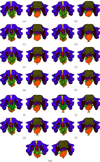A logarithmic opinion pool based STAPLE algorithm for the fusion of segmentations with associated reliability weights
- PMID: 24951681
- PMCID: PMC4264575
- DOI: 10.1109/TMI.2014.2329603
A logarithmic opinion pool based STAPLE algorithm for the fusion of segmentations with associated reliability weights
Abstract
Pelvic floor dysfunction is common in women after childbirth and precise segmentation of magnetic resonance images (MRI) of the pelvic floor may facilitate diagnosis and treatment of patients. However, because of the complexity of its structures, manual segmentation of the pelvic floor is challenging and suffers from high inter and intra-rater variability of expert raters. Multiple template fusion algorithms are promising segmentation techniques for these types of applications, but they have been limited by imperfections in the alignment of templates to the target, and by template segmentation errors. A number of algorithms sought to improve segmentation performance by combining image intensities and template labels as two independent sources of information, carrying out fusion through local intensity weighted voting schemes. This class of approach is a form of linear opinion pooling, and achieves unsatisfactory performance for this application. We hypothesized that better decision fusion could be achieved by assessing the contribution of each template in comparison to a reference standard segmentation of the target image and developed a novel segmentation algorithm to enable automatic segmentation of MRI of the female pelvic floor. The algorithm achieves high performance by estimating and compensating for both imperfect registration of the templates to the target image and template segmentation inaccuracies. A local image similarity measure is used to infer a local reliability weight, which contributes to the fusion through a novel logarithmic opinion pooling. We evaluated our new algorithm in comparison to nine state-of-the-art segmentation methods and demonstrated our algorithm achieves the highest performance.
Figures





Similar articles
-
Simultaneous truth and performance level estimation through fusion of probabilistic segmentations.IEEE Trans Med Imaging. 2013 Oct;32(10):1840-52. doi: 10.1109/TMI.2013.2266258. Epub 2013 Jun 4. IEEE Trans Med Imaging. 2013. PMID: 23744673 Free PMC article.
-
Multi-atlas segmentation of the whole hippocampus and subfields using multiple automatically generated templates.Neuroimage. 2014 Nov 1;101:494-512. doi: 10.1016/j.neuroimage.2014.04.054. Epub 2014 Apr 29. Neuroimage. 2014. PMID: 24784800
-
Simultaneous truth and performance level estimation (STAPLE): an algorithm for the validation of image segmentation.IEEE Trans Med Imaging. 2004 Jul;23(7):903-21. doi: 10.1109/TMI.2004.828354. IEEE Trans Med Imaging. 2004. PMID: 15250643 Free PMC article.
-
Segmentations of MRI images of the female pelvic floor: a study of inter- and intra-reader reliability.J Magn Reson Imaging. 2011 Mar;33(3):684-91. doi: 10.1002/jmri.22478. J Magn Reson Imaging. 2011. PMID: 21563253 Free PMC article.
-
Estimation of inferential uncertainty in assessing expert segmentation performance from STAPLE.IEEE Trans Med Imaging. 2010 Mar;29(3):771-80. doi: 10.1109/TMI.2009.2036011. IEEE Trans Med Imaging. 2010. PMID: 20199913 Free PMC article.
Cited by
-
Investigation of an efficient multi-modal convolutional neural network for multiple sclerosis lesion detection.Sci Rep. 2023 Nov 30;13(1):21154. doi: 10.1038/s41598-023-48578-4. Sci Rep. 2023. PMID: 38036638 Free PMC article.
-
Advances in Fetal Brain Imaging.Magn Reson Imaging Clin N Am. 2024 Aug;32(3):459-478. doi: 10.1016/j.mric.2024.03.004. Epub 2024 Apr 29. Magn Reson Imaging Clin N Am. 2024. PMID: 38944434 Free PMC article. Review.
-
A fully automated pipeline for brain structure segmentation in multiple sclerosis.Neuroimage Clin. 2020;27:102306. doi: 10.1016/j.nicl.2020.102306. Epub 2020 Jun 4. Neuroimage Clin. 2020. PMID: 32585568 Free PMC article.
-
Tubers are neither static nor discrete: Evidence from serial diffusion tensor imaging.Neurology. 2015 Nov 3;85(18):1536-45. doi: 10.1212/WNL.0000000000002055. Epub 2015 Oct 2. Neurology. 2015. PMID: 26432846 Free PMC article.
-
Optimal MAP Parameters Estimation in STAPLE Using Local Intensity Similarity Information.IEEE J Biomed Health Inform. 2015 Sep;19(5):1589-97. doi: 10.1109/JBHI.2015.2428279. Epub 2015 Apr 30. IEEE J Biomed Health Inform. 2015. PMID: 25955854 Free PMC article.
References
-
- Bump RC, Norton PA. Epidemiology and natural history of pelvic floor dysfunction. Obstetrics and gynecology clinics of North America. 1998;25(4):723–746. - PubMed
-
- Bump RC, Mattiasson A, Bø K, Brubaker LP, DeLancey JOL, Klarskov P, Shull BL, Smith ARB. The standardization of terminology of female pelvic organ prolapse and pelvic floor dysfunction. American journal of obstetrics and gynecology. 1996;175(1):10–17. - PubMed
-
- Bassaly R, Tidwell N, Bertolino S, Hoyte L, Downes K, Hart S. Myofascial pain and pelvic floor dysfunction in patients with interstitial cystitis. International Urogynecology Journal. 2011;22(4):413–418. - PubMed
-
- Hoyte L, Damaser MS, Warfield SK, Chukkapalli G, Majumdar A, Choi DJ, Trivedi A, Krysl P. Quantity and distribution of levator ani stretch during simulated vaginal childbirth. American journal of obstetrics and gynecology. 2008;199(2):198–e1. - PubMed
-
- Hoyte L, Damaser MS. Magnetic resonance-based female pelvic anatomy as relevant for maternal childbirth injury simulations. Annals of the New York Academy of Sciences. 2007;1101(1):361–376. - PubMed
Publication types
MeSH terms
Grants and funding
LinkOut - more resources
Full Text Sources
Other Literature Sources
Medical

